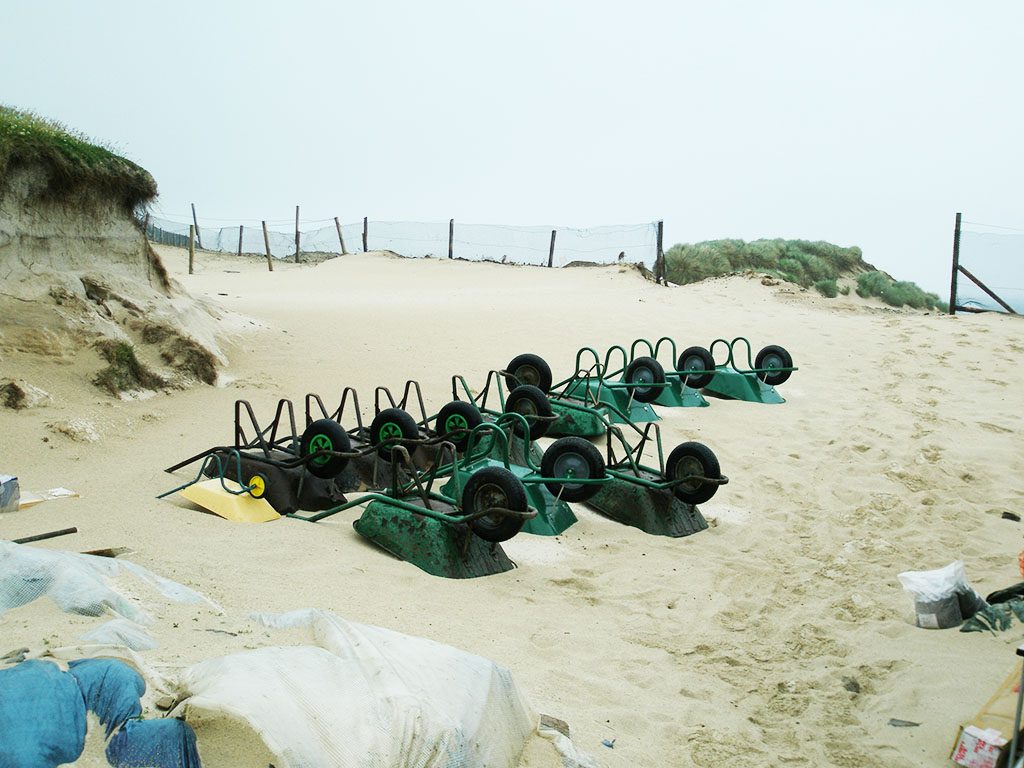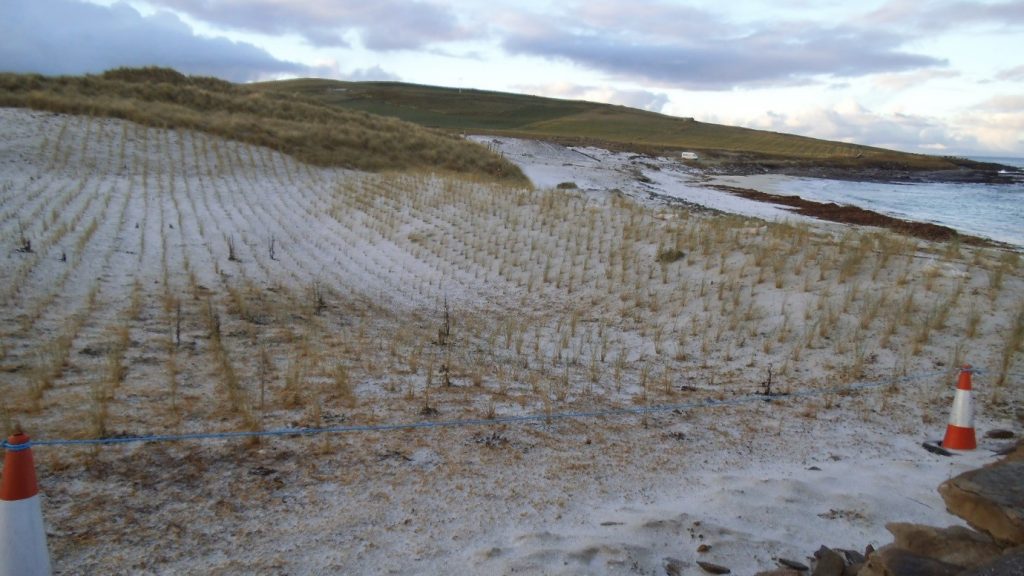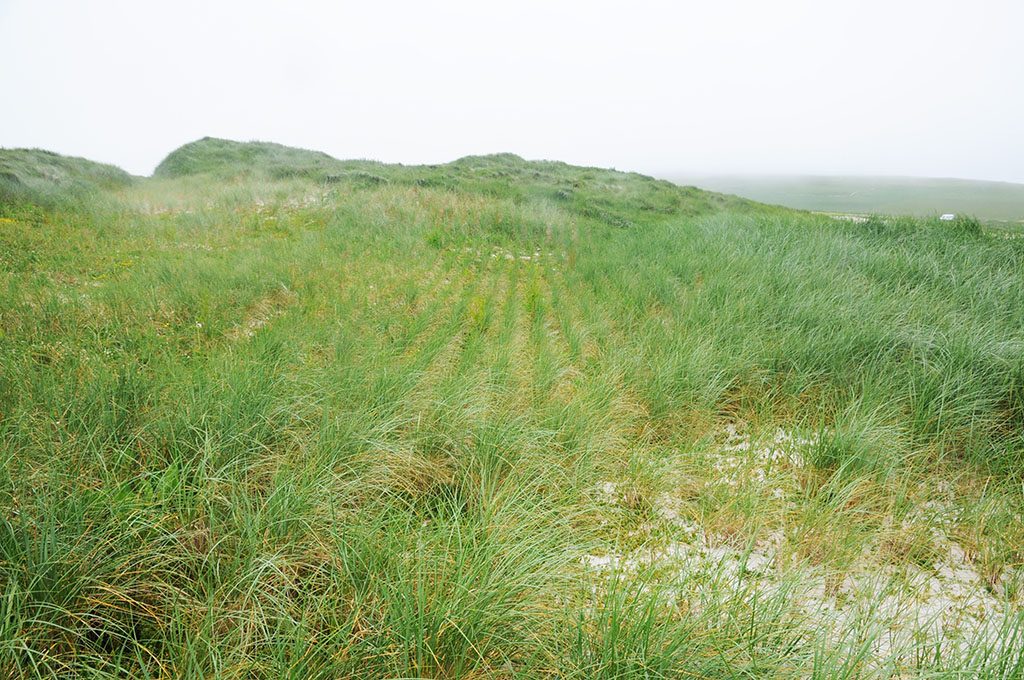Shifting Sands at Links of Noltland
Conservation | Written by: Duncan Ainslie | Friday 31 March 2017
Orkney is home to some of Scotland’s oldest surviving buildings. At Links of Noltland, first settled over 4000 years ago, our Estates team is working to save these buildings for future generations.
Links of Noltland occupies about 4 hectares of sand dunes and coastal machair (grassland) on the north coast of Westray. Sand has been building up and then wearing away here for thousands of years. However, by the mid-20th century, the balance had shifted. The amount of sand being worn away was no longer being cancelled out by the amount that was building up. This meant that overall, the depth of sand covering the area was decreasing. By the late 20th century, large areas of the dunes had become badly eroded.

Wheelbarrows lying on the beach at Noltland…

…and 36 hours later
Prehistoric landscape protected by dunes
In 2007-8, archaeological assessment at Links of Noltland found that prehistoric remains there were being threatened by this erosion. A rescue archaeology project began in 2009. Extensive and impressive archaeological remains were revealed, most famously the Orkney Venus, known locally as the ‘Westray Wife’.
The archaeology found at Links of Noltland represents the evolution of a landscape which was settled continuously for around 3000 years, including at least 33 Neolithic and Bronze Age houses. Many of these buildings are clustered into settlements, surrounded by the remnants of cemeteries, artefact-rich middens (waste dumps) and farmland. There were butchery areas, an underground well, pottery kilns, field boundaries and even an underground sauna. After they were abandoned, these settlements were engulfed by sand. Until recently, they lay hidden and protected beneath the dunes. Because the sand was so deep, their remains have survived virtually unscathed up to the present day.

Grobust building, similar to those found at Skara Brae
The Neolithic structures at Links of Noltland have similarities with both Skara Brae and the recently excavated Ness of Brodgar. In particular, the Neolithic “Grobust” buildings at Noltland are very similar to those found at Skara Brae. Half-buried in midden, they had thick stone walls, a central hearth for the fire, and the same distinctive stone “dressers” as the Skara Brae houses. Excavation of the main floor levels of one building revealed a complicated system of underfloor drainage, with a self-filling corner cistern fed by a natural spring.
For more information on the effects of coastal erosion on archaeological sites, check out our publications.
Stabilising the sand
Our Estates Team Conservation Unit have been working alongside the archaeologists in the Cultural Resources Team to stabilise the dunes, protecting the ancient settlement. We’ve been focusing on areas where we think there archaeological remains are buried, making sure they stay protected below the dunes, and encouraging vegetation growth to stop sand from blowing inland.
Traditionally, stabilising involves shaping and sculpting the dunes with bulldozers. However, because of the sensitive archaeology at Links of Noltland, we had to look at different, less invasive methods. Instead, we carried out a “dune recharge”. Sand from a local quarry was brought in to build up the dunes and, importantly, used to fill in the gaps between existing eroding dunes. Narrow gaps cause accelerated wind speeds, undercutting the exposed dune edges and quickly leading to the dune collapsing.

The Conservation team hard at work planting grasses
Once the sand had been laid we planted the dunes with marram and lyme grasses. Their roots will help to anchor the sand dunes, breaking up the impact of incoming winds and catching sand grains. This will slowly build the dunes back up again.

Links of Noltland planted with grasses…

…and six months later
With the dunes now stabilised, the as-yet uncovered remains of the Noltland settlements will stay protected. In the areas that have already been revealed, excavations usually take place during the summer. If you can’t make the trip to Orkney, check out an interactive aerial tour of the excavations, or keep up to date with the dig on Facebook.
About the author:
Duncan Ainslie
Duncan provides support to the Estates team of the Conservation Directorate at Historic Environment Scotland. With a background in history, he enjoys learning about the significance of our properties and the stories we’re able to perpetuate through our conservation work.
View all posts by Duncan Ainslie



